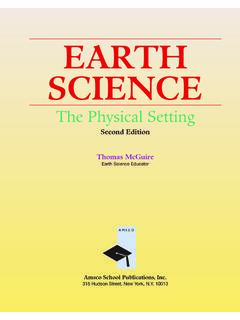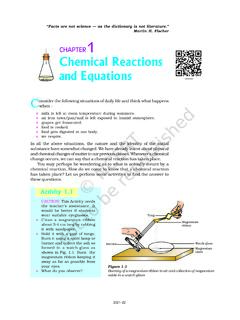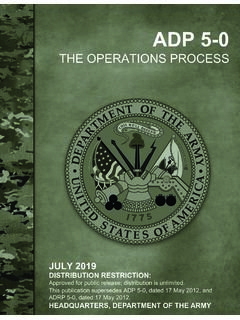Transcription of CHAPTER15 Our Environment - NCERT
1 Science256 Activity Environment15 CHAPTERWe have heard the word Environment often being used on thetelevision, in newspapers and by people around us. Our elders tellus that the Environment is not what it used to be earlier; others say thatwe should work in a healthy Environment ; and global summits involvingthe developed and developing countries are regularly held to discuss environmental issues. In this chapter , we shall be studying how variouscomponents in the Environment interact with each other and how weimpact the ECO-SYSTEM WHA-SYSTEM WHA-SYSTEM WHA-SYSTEM WHA-SYSTEM WHAT ARE ITS COMPONENTS?
2 T ARE ITS COMPONENTS?T ARE ITS COMPONENTS?T ARE ITS COMPONENTS?T ARE ITS COMPONENTS?All organisms such as plants, animals, microorganisms and humanbeings as well as the physical surroundings interact with each otherand maintain a balance in nature. All the interacting organisms in anarea together with the non-living constituents of the Environment forman ecosystem. Thus, an ecosystem consists of biotic componentscomprising living organisms and abiotic components comprisingphysical factors like temperature, rainfall, wind, soil and example, if you visit a garden you will find different plants, suchas grasses, trees; flower bearing plants like rose, jasmine, sunflower;and animals like frogs, insects and birds.
3 All these living organismsinteract with each other and their growth, reproduction and otheractivities are affected by the abiotic components of ecosystem. So a gardenis an ecosystem. Other types of ecosystems are forests, ponds and are natural ecosystems while gardens and crop-fields are human-made (artificial) might have seen an aquarium. Let us try to design are the things that we need to keep in mind when we createan aquarium? The fish would need a free space for swimming (itcould be a large jar), water, oxygen and can provide oxygen through an oxygen pump (aerator) andfish food which is available in the 22 Our Environment257nIf we add a few aquatic plants and animals it can become a self-sustaining system.
4 Can you think how this happens? An aquariumis an example of a human-made we leave the aquarium as such after we set it up? Why doesit have to be cleaned once in a while? Do we have to clean pondsor lakes in the same manner? Why or why not?We have seen in earlier classes that organisms can be grouped asproducers, consumers and decomposers according to the manner inwhich they obtain their sustenance from the Environment . Let us recallwhat we have learnt through the self sustaining ecosystem created byus above. Which organisms can make organic compounds like sugarand starch from inorganic substances using the radiant energy of theSun in the presence of chlorophyll?
5 All green plants and certain bacteriawhich can produce food by photosynthesis come under this categoryand are called the depend on the producers either directly or indirectly fortheir sustenance? These organisms which consume the food produced,either directly from producers or indirectly by feeding on other consumersare the consumers. Consumers can be classed variously as herbivores,carnivores, omnivores and parasites. Can you give examples for each ofthese categories of consumers?nImagine the situation where you do not clean the aquarium andsome fish and plants have died. Have you ever thought whathappens when an organism dies?
6 The microorganisms, comprisingbacteria and fungi, break-down the dead remains and wasteproducts of organisms. These microorganisms are the decomposersas they break-down the complex organic substances into simpleinorganic substances that go into the soil and are used up oncemore by the plants. What will happen to the garbage, and deadanimals and plants in their absence? Will the natural replenishmentof the soil take place, even if decomposers are not there?Activity creating an aquarium did you take care not to put an aquaticanimal which would eat others? What would have happenedotherwise?nMake groups and discuss how each of the above groups oforganisms are dependent on each the aquatic organisms in order of who eats whom and forma chain of at least three steps.
7 NWould you consider any one group of organisms to be of primaryimportance? Why or why not?2021 22 Science258 Figure ophic Food Chains and WebsIn Activity we have formed a series of organisms feedingon one another. This series or organisms taking part atvarious biotic levels form a food chain (Fig. ).Each step or level of the food chain forms a trophic autotrophs or the producers are at the first trophic fix up the solar energy and make it available forheterotrophs or the consumers. The herbivores or the primaryconsumers come at the second, small carnivores or thesecondary consumers at the third and larger carnivores orthe tertiary consumers form the fourth trophic level (Fig.)
8 We know that the food we eat acts as a fuel to provide usenergy to do work. Thus the interactions among variouscomponents of the Environment involves flow of energy fromone component of the system to another. As we have studied,the autotrophs capture the energy present in sunlight andconvert it into chemical energy. This energy supports all theactivities of the living world. From autotrophs, the energy goesto the heterotrophs and decomposers. However, as we saw inthe previous chapter on Sources of Energy , when one formof energy is changed to another, some energy is lost to theenvironment in forms which cannot be used again.
9 The flowof energy between various components of the environmenthas been extensively studied and it has been found that nThe green plants in a terrestrial ecosystem capture about1% of the energy of sunlight that falls on their leaves and convert itinto food green plants are eaten by primary consumers, a great dealof energy is lost as heat to the Environment , some amount goesinto digestion and in doing work and the rest goes towards growthand reproduction. An average of 10% of the food eaten is turnedinto its own body and made available for the next level , 10% can be taken as the average value for the amountof organic matter that is present at each step and reaches the nextlevel of so little energy is available for the next level of consumers,food chains generally consist of only three or four steps.
10 The lossof energy at each step is so great that very little usable energyremains after four trophic are generally a greater number of individuals at the lowertrophic levels of an ecosystem, the greatest number is of length and complexity of food chains vary greatly. Each organismis generally eaten by two or more other kinds of organisms which inturn are eaten by several other organisms. So instead of a straightline food chain, the relationship can be shown as a series of branchinglines called a food web (Fig. ).Figure chain in nature(a) in forest, (b) ingrassland and (c) in apond2021 22 Our Environment259 From the energy flow diagram (Fig.)
















